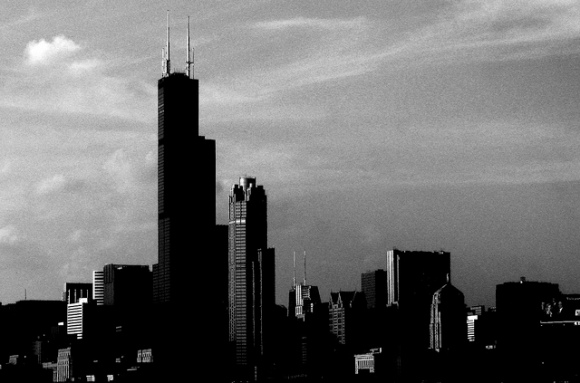What should we desire from our fiction? Deep and thoughtful prose that expands our vocabulary and contemporary vernacular? Elaborate plots with twists and turns through the myriad of human actions, reactions and interactions? A keen sense of place and time? Life affirming one-liners? Drama? Comedy? Absurdity? Obviously, there is no one answer to what gives life to great fiction. The definition is as varied as the minds that create it.
In our city, that includes Algren, Wright, Cisernos, Bellows…the list goes on. Great fiction is generally believed to be heavy, as any reader of Native Son can tell you. But what Michael Czyzniejewski does with Chicago Stories: 40 Dramatic Fictions is simplify interesting narratives and bridge gaps between separate worlds and time-periods that exist within the same Chicagoland boundary.
The forty stories range from a paragraph to three pages maximum, often accompanied by a sketch of the protagonist (illustrations by Rob Funderbunk). The first story is already loaded with historical references: “Mrs. O’Leary’s Ghost Comforts Steve Bartman at the Ruins of Meigs Field,” in which the infamous farmer reminds the infamous fan that there is always a chance to start over, that “that cow never gave much milk anyway,” while providing mythological examples along the way. Not only does Czyzniejewski create delightfully absurd titles, but he follows through in his brief chapters.
There is never any dialogue, even when multiple people are cited in the titles, but it helps to imagine the multiple personalities transcending space and time to relate to each other. Take for instance Sister Carrie Facebooking Frankie Machine or Soldier Field responding to its critics after all of the spaceship comparisons. Two chapters rarely relate to another, but one about the history of the Ferris Wheel is followed by Pat Sajak explaining the existential significance of his Wheel of Fortune. But outside of that, what’s impressive of the book is how varied each chapter is from one another. Sometimes you can hear the narrator’s voice in your head, like Blagojevich’s colorful language or Dennis Rodman envisioning his final tattoo. Sometimes you have to anthropomorphize objects, like the 16-inch softball giving advice to an Italian Beef sandwich. Sometimes you laugh (“Ann Landers Advises Against the Use of Twitter”). Sometimes you think (“The Water Tower Suffers Post-Traumatic Stress Disorder”). Sometimes you find a Chicago connection you didn’t know existed (“David Hasselhoff Enlists as an Organ Donor”).
Overall the book remains playful, but never becomes dull. The format makes it easy to pick up and put down during your commute, but it’s so smooth to read that you can take it in all in one afternoon. The references cover all areas of our city’s history — politics, sports, crime, music, science, and more — juxtaposing national celebrities (Roger Ebert on a date with Oprah, Gil Scott-Heron leaving a voicemail for R. Kelly) with more obscure local references (Ray Kroc, David Yow, Skip Dillard). Naturally, there is much omitted. But the lack of Frank Lloyd Wright, Charlie Trotter, Jerry Springer, John Dillinger, and Chess Records references promise (hopefully) another forty stories in the future.








